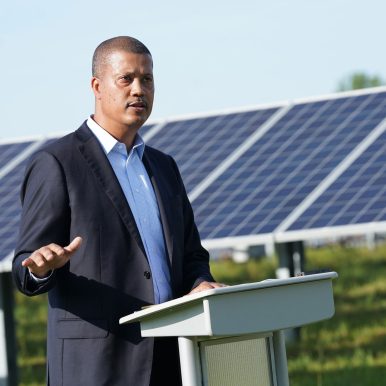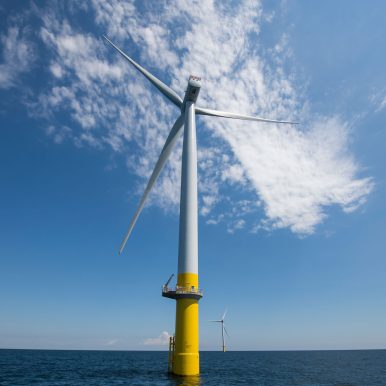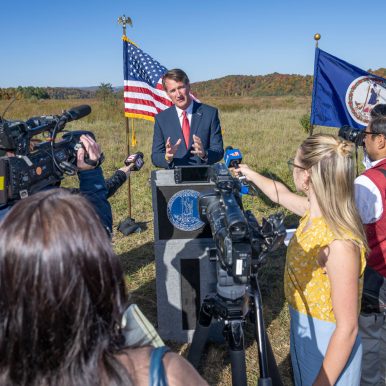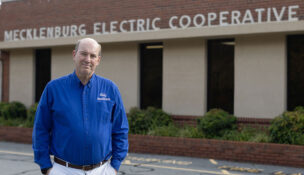Balance of power
Grid transformation offers challenges, opportunities
Paul Bibeau //March 30, 2023//
Balance of power
Grid transformation offers challenges, opportunities
Paul Bibeau //March 30, 2023//
Chris Rawlings was a mechanic who wanted to be a pilot.
He left the Marine Corps in 2008 after deploying twice to Iraq, where he supervised an aircraft maintenance team, going on to perform similar duties as a civilian contractor in a hangar at Fort Eustis. But his plan was to get back into the service.
“My dream was always to fly fighter jets for the Marine Corps,” he says, but something unexpected happened, and Rawlings instead found his next career.
His boss at the hangar asked him to study ways to improve efficiency, and as Rawlings poked around, he noticed the “massive amount” of money the place was wasting from energy losses with temperature-controlled air blowing out hangar doors or leaking through hoses. Going green could save the operation a lot of money, he realized, and the idea stuck with him.
In 2014, Rawlings launched Richmond-based Bowerbird Energy LLC, which focuses on helping businesses cut their power costs. Nine years later, Bowerbird is “a multimillion-dollar business,” with more than 350 clients nationwide, Rawlings says. The company designs LED lighting arrays and HVAC systems, and it creates feasibility studies and energy plans for businesses interested in reducing their carbon footprints or switching to renewable energy.

“There’s so much opportunity in the energy industry,” Rawlings says.
As Virginia moves to transform its electric grid to carbon-free, renewable energy in the face of climate change, it’s creating enormous opportunities for businesses big and small.
“When you’re transforming the grid, you’re making big changes. It takes a lot of work to get that done and you need qualified people to do that work,” says Rawlings, who anticipates that grid transformation will likely result in contracts and job creation for Bowerbird and other small businesses like his.
The renewable energy market was an $881.7 billion global industry in 2020, according to Portland, Oregon-based Allied Market Research, which projects it will grow to $1.98 trillion by 2030 as governments and industries push to reduce or eliminate greenhouse gas emissions in the face of climate change.
Here in Virginia, in 2020, the then-Democratic-majority Virginia General Assembly passed the Virginia Clean Economy Act (VCEA), requiring all electricity in Virginia to be produced from carbon-free power sources no later than 2050.
Political leaders, environmental activists, lobbyists and energy executives say the transition will be challenging. In addition to creating carbon-free clean energy, grid transformation can also be expected to generate controversies, technical difficulties and tradeoffs.
Bob McNab, economics department chair at Old Dominion University and director of ODU’s Dragas Center for Economic Analysis and Policy, says the renewable energy economy is projected to surge ahead of fossil fuels over the next 30 years.
What’s happening now, he adds, resembles earlier industrial revolutions in computers and cars that brought economic booms. And it poses a stark challenge: “Will Virginia lead or will Virginia follow?”
For environmental activists like Dan Crawford, chair of the Roanoke group of the Sierra Club, the transition to renewable energy is more than a business or government matter, though — it’s an existential crisis for humanity, as scientists warn that the world is on the precipice of a series of catastrophic tipping points.
“Climate change is not going to happen. It’s happening,” Crawford says, adding that switching to renewables might help save us from some terrible impacts, the worst of which “would be that no humans survive.”
Ambitious targets
Under the VCEA, Richmond-based Dominion Energy Inc., the Fortune 500 utility that serves 64.4% of Virginia, is mandated to produce all of its power for its customers in the state from renewable energy sources by 2045. Columbus, Ohio-headquartered Appalachian Power Co., which serves about 14% of the commonwealth, must meet the same target by 2050.

The law also requires Appalachian to increase its energy storage capacity by 400 megawatts and Dominion to boost its capacity by 2,700 megawatts, pending approval by the State Corporation Commission — all by 2035.
Finally, the General Assembly has required Dominion to have offshore wind projects capable of producing 5.2 gigawatts by 2032.
Toward this end, Dominion is developing its $9.8 billion offshore wind farm. Located 27 miles off the coast of Virginia Beach, when finished in 2026, it is expected to provide power for up to 660,000 customers.
The VCEA also grandfathers in existing nuclear power plants, allowing nuclear energy to be in the carbon-free mix with renewable energy sources such as wind and solar. (However, somewhat contradictorily, the VCEA excludes nuclear energy from its definition of renewable energy sources.)
The size and scope of Virginia’s energy grid and the commonwealth’s growing power needs are impressive and make grid transformation appear to be a daunting task.
State utilities generated 103.1 terawatt-hours of power in 2020, according to the Virginia Department of Energy. (One terawatt-hour is enough to light 1 million homes for a year.) And Virginia’s electricity demands are predicted to grow by more than 78% by 2050, according to a 2021 report from the University of Virginia’s Weldon Cooper Center for Public Service. Virginia’s status as the state with the world’s largest concentration of power-hungry data centers as well as mass adoption of electric vehicles are expected to be key drivers of that demand, the report concluded.
Yet, so far, Dominion and Appalachian have a long way to go to meet the carbon-free mandate.
Last year, just 5% of energy produced by Dominion’s Virginia Power came from renewables, up slightly from 4% in 2020. Natural gas accounted for 41% and nuclear energy was responsible for 43% of electricity generated by Dominion. Coal accounted for 11%. (Natural gas and coal emit greenhouse gases methane and carbon dioxide, which contribute to climate change.)
As for Appalachian, across all its service areas in Virginia, West Virginia and Tennessee, 16.6% of its power comes from hydroelectric, wind and solar sources, while 63.8% is generated by coal and 19.6% comes from natural gas when operating at full capacity. The company estimates that about 8% of energy for its Virginia customers comes from its own or contracted renewable energy sources.
Dominion and Appalachian executives say they’re optimistic they will hit the 2045 and 2050 targets set by the VCEA, while cautioning that fluctuations in power produced from renewables make grid reliability a challenge as the use of renewables expands.
Cliona Mary Robb, an energy law attorney at Richmond-based Thompson McMullan PC law firm and chair of the Virginia Renewable Energy Alliance, an industry group supporting renewable energy awareness, says the two utilities could meet VCEA deadlines under the current framework “if they are absolutely forced to,” but she notes that the state’s electric utility regulatory laws are “constantly changing,” and she doesn’t expect that to change anytime soon.
Appalachian President and Chief Operating Officer Aaron Walker, meanwhile, says he wants to shift his utility’s Virginia operations to carbon-free renewables “as fast as we can — as long as we’re protecting the overall reliability, security and affordability of the grid.”
Dominion Energy Virginia President Ed Baine is even more blunt: “When your lights are off, that’s the only thing that matters.”

Prevailing winds
Regardless of caveats, Dominion and Appalachian have taken big steps since 2020 to launch renewables projects, with promises that the transformation will create thousands of new jobs.
In addition to its offshore wind project, Dominion has filed proposals with state officials for at least 23 solar and energy storage projects totaling 800 megawatts, enough to power more than 200,000 homes, with SCC approval anticipated in mid-April. And last year, Appalachian Power filed a plan to acquire or contract for solar power projects totaling 294 megawatts and wind power projects totaling 204 megawatts over the next three years.
Appalachian notes, however, that four of their solar projects were dropped by developers due to development or cost issues. “While disappointing, we are still able to meet our Clean Economy Act [annual progress] requirements,” a spokesperson says. In mid-March, the utility was set to file an updated plan with the SCC that includes several new renewable energy projects.
Meanwhile, Dominion expects to propose between 800 and 1,000 megawatts of new solar and energy storage projects each year through 2035, as it has for the past three years under VCEA requirements.
Despite this forward momentum from the utilities, state Republicans have been pushing back on the Clean Energy Act, with Gov. Glenn Youngkin calling for the act to be reevaluated this year and every five years going forward. In October 2022, he issued his own alternative vision for the state’s power grid, a proposal endorsing an “all-of-the-above” mix of energy sources, including natural gas and nuclear power. This is in keeping with national GOP messaging that a hasty grid transition away from coal and natural gas could result in crashing grids and brownouts.
“We did incredible work in the 2020 [General Assembly] session in passing the Virginia Clean Economy Act. We have our target — it’s a great target — but what matters now is smart implementation,” says Andrew Grigsby, energy services director with Richmond-based nonprofit green energy consulting firm Viridiant. “The big solar farms and the big wind farms are astounding technology. … [It will be] a more complicated grid — no doubt about that — just as my iPhone is more complicated than my calculator from 1996. But any resistance to the clean energy transformation is kind of sad.”
Political pushback and technological challenges notwithstanding, U.S. Rep. Jennifer McClellan, who, as a state senator, co-sponsored the VCEA, is optimistic Virginia will meet the 2045 and 2050 deadlines, saying that grid transformation is showing early promise.
“We’re already seeing progress with the rapid growth of solar in the state, offshore wind development and more robust energy efficiency,” McClellan says. “That has meant thousands of new jobs and more affordable energy for Virginians. … If anything, we might be able to hit our goals ahead of schedule.”
Perhaps the most significant advance in renewables is rising out of the waters off Virginia Beach’s coast where Dominion is working on its massive 2.6-gigawatt Coastal Virginia Offshore Wind project. The project will include 176 wind turbines, each towering 800 feet tall and capable of producing 14.7 megawatts.
“[It] will likely be the largest capital investment and single largest project in the history of Dominion Energy Virginia,” the State Corporation Commission concluded in a September 2022 order approving rate hikes associated with the project.
A 2020 study published by the Hampton Roads Alliance projected that operation and maintenance of the offshore wind farm will support more than 1,100 full-time jobs in Hampton Roads, paying $82 million in pay and benefits. That would generate an additional $210 million in economic impact and net $6 million in tax revenues for localities and $5 million for the state government. Additionally, the project is expected to create 900 construction jobs per year through 2026, providing $57 million in pay and benefits.
Further, ancillary offshore wind businesses could create an additional 5,200 full-time jobs, with $270 million in pay and benefits, according to the study, with an additional $740 million in economic output expected for each gigawatt of new offshore wind energy development the region services, according to the study.
Sunshine state
Utility-scale solar farms are popping up across Virginia, but the land-intensive projects have faced concerted opposition. A report by the Virginia Coastal Policy Center at William & Mary Law School indicates solar farms can be contentious in rural counties, partly because “the types of crops most likely to be displaced by utility-scale solar installations are corn, soybeans, cotton and wheat, which are also among the most-planted crops statewide.”

Localities that once embraced solar farms for unused land have started pushing back on some projects. In March 2022, Page County officials rejected a 571-acre solar project, and in December 2022, Rockingham County officials quashed two proposed solar farms. This January, Culpeper County denied a 1,900-acre solar project.
Last August, however, Charlotte County greenlit the state’s largest proposed solar farm to date, the $800 million to $1.6 billion Randolph Solar project. The 800-megawatt solar farm is expected to generate power for 200,000 homes. The developer, Reston-based SolUnesco, sold the project to Dominion after receiving approval.
But to reach this point, SolUnesco had to build consensus painstakingly, says founder and CEO Francis Hodsoll. The Randolph Solar project had to get buy-in from more than 150 landowners who collectively owned more than 1,000 parcels of land around the site.
Richmond-based attorney and lobbyist Greg Habeeb represents renewable development projects across Virginia in his role as president of Gentry Locke Consulting, an arm of Roanoke-based Gentry Locke Attorneys. The solar industry is getting better at working with local governments to create comprehensive agreements that cover potential impacts from solar farms, such as increased traffic, he says, and this helps build community support for the projects.
As the solar industry grows, Virginia will also require more utility-scale battery storage to make the grid reliable. Last year, Dominion began operating its largest battery energy storage pilot project at the Scott Solar + Storage facility in Powhatan County, which provides 12 megawatts of storage. The company has two smaller projects in New Kent and Hanover counties.
Fusion point
Advancing nuclear technology could also play a role in transforming the grid, and it’s an area in which there’s some bipartisan agreement. Youngkin has called for the country’s first small modular reactor (SMR) to be built in Southwest Virginia within 10 years, and McClellan has said that the development of new nuclear energy technology could help meet VCEA targets.
As planned by the U.S. Department of Energy, SMRs will vary in output from tens to hundreds of megawatts and have safety features that older, larger nuclear plants lack.
Dominion Energy, which has been considering several SMR reactor designs under review by the U.S. Nuclear Regulatory Commission, says nuclear power is a necessary part of its grid transformation plans. SMRs, the utility says, will present an “opportunity to provide an additional energy source which is available at all hours of the day to complement renewable energy.”
Dominion received approval in 2021 to extend the operational lifespan of its Surry nuclear power plant into the early 2050s; it has additionally sought to extend the life of its nuclear plant at North Anna to 2060, a matter still under review by the NRC.
A bill to establish an SMR pilot program failed in the General Assembly this session, but nuclear energy is still a hot topic among state energy stakeholders, says Robb with the Virginia Renewable Energy Alliance. With a membership that includes Dominion, Appalachian and several solar companies, the alliance sponsored a nuclear energy summit last September. “I think we’ve been sensing since last year that SMRs would play a role” in grid transformation, she explains.
Despite this year’s legislative setback for SMRs, Robb sees a place for nuclear power in the VCEA framework, although, she adds, the state’s energy policy will depend on which political party controls the legislature. All 140 General Assembly seats are on the ballot in November and many senior legislators are retiring, lending an uncertain outlook on the legislature’s balance of power.
“Coal is on its way out, but natural gas is still around,” Robb says. “I’ve often looked at natural gas as a bridge fuel” — between fossil fuels to renewable energy. “If SMRs work, their role [will be] replacing natural gas as a bridge fuel. I’m eagerly awaiting the results of the election.”
Virginia Business Deputy Editor Kate Andrews contributed to this story.
C
















